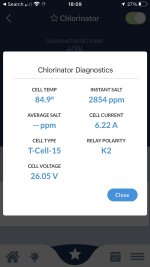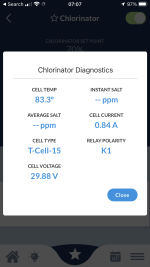Troubleshooting an issue with my SWG/Cell this year. System is now going on 6 years old. Noticed chlorine output was low and started digging. Taylor K1766 test kit salt reading is pretty close (2800) to the Omnilogic calc, so salt level is good. The average salt reading is out of whack due to the K1 issue, if you reset the average when it is on K2 it calculates average without issue.
Found that when the SWG is on K2 (polarity switching), everything is normal and a good 6 or so amps.

When the SWG is on K1, voltage is 29v and current is around 1 amp.

So it would appear when K1 is on the T-Cell is not generating properly (low current). I would think I could just reverse the power connections on the salt cell cable so I can see if it’s actually the K1 circuit or the T-Cell itself.
Temporarily doubling the cell on time has solved the low chlorine issue (k2 is now running twice as much) but would rather dig into the issue of course.
—-
I’ll inspect the cell today and check the Omnilogic PCB for obvious faults. Just curious if this is a common symptom of a failing/failed T-cell?
Do we have an in-depth method of testing salt cells documented anywhere? I didn’t see anything in the reading further.
Cheers
Tim
Found that when the SWG is on K2 (polarity switching), everything is normal and a good 6 or so amps.

When the SWG is on K1, voltage is 29v and current is around 1 amp.

So it would appear when K1 is on the T-Cell is not generating properly (low current). I would think I could just reverse the power connections on the salt cell cable so I can see if it’s actually the K1 circuit or the T-Cell itself.
Temporarily doubling the cell on time has solved the low chlorine issue (k2 is now running twice as much) but would rather dig into the issue of course.
—-
I’ll inspect the cell today and check the Omnilogic PCB for obvious faults. Just curious if this is a common symptom of a failing/failed T-cell?
Do we have an in-depth method of testing salt cells documented anywhere? I didn’t see anything in the reading further.
Cheers
Tim
Last edited:

